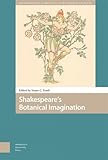Shakespeare's Botanical Imagination / ed. by Susan C. Staub.
Material type: TextSeries: Environmental Humanities in Pre-Modern Cultures ; 5Publisher: Amsterdam : Amsterdam University Press, [2023]Copyright date: ©2023Description: 1 online resource (302 p.)Content type:
TextSeries: Environmental Humanities in Pre-Modern Cultures ; 5Publisher: Amsterdam : Amsterdam University Press, [2023]Copyright date: ©2023Description: 1 online resource (302 p.)Content type: - 9789048551101
- Botany in literature
- English literature -- History and criticism -- Early modern, 1500-1700
- English literature -- Early modern, 1500-1700 -- History and criticism
- Human-plant relationships in literature
- Early Modern Studies
- Environment and Sustainability
- History, Art History, and Archaeology
- Literary Theory, Criticism, and History
- ART / Environmental & Land Art
- Shakespeare, botany, plants, ecocriticism, ecofeminism
- 822.33 23/eng/20230221
- PR3041 .S53 2023
- online - DeGruyter
| Item type | Current library | Call number | URL | Status | Notes | Barcode | |
|---|---|---|---|---|---|---|---|
 eBook
eBook
|
Biblioteca "Angelicum" Pont. Univ. S.Tommaso d'Aquino Nuvola online | online - DeGruyter (Browse shelf(Opens below)) | Online access | Not for loan (Accesso limitato) | Accesso per gli utenti autorizzati / Access for authorized users | (dgr)9789048551101 |
Frontmatter -- Table of Contents -- List of Figures -- Acknowledgments -- Introduction -- Part 1. Plant Power and Agency -- 1. Vegetable Virtues -- 2. The “idle weeds that grow in the sustaining corn”: Generating Plants in King Lear -- 3. Botanical Barbary: Punning, Race, and Plant Life in Othello 4.3 -- Part 2. Human-Vegetable Affinities and Transformations -- 4. Shakespeare’s Botanical Grace -- 5. “Circummured” Plants and Women in Measure for Measure -- 6. Cymbeline’s Plant People -- 7. ‘Thou art translated’: Plants of Passage in A Midsummer Night’s Dream -- Part 3. Plants and Temporalities -- 8. Clockwork Plants and Shakespeare’s Overlapping Notions of Time -- 9. The Verdant Imagination in Shakespeare’s Sonnets -- 10. The Botanical Revisions of 3 Henry VI -- 11. Botanomorphism and Temporality: Imagining Humans as Plants in Two Shakespeare Plays -- Afterword -- Index
restricted access online access with authorization star
http://purl.org/coar/access_right/c_16ec
Writing on the cusp of modern botany and during the heyday of English herbals and garden manuals, Shakespeare references at least 180 plants in his works and makes countless allusions to horticultural and botanical practices. Shakespeare’s Botanical Imagination moves plants to the foreground of analysis and brings together some of the rich and innovative ways that scholars are expanding the discussion of plants and botany in Shakespeare’s writings. The essays gathered here all emphasize the interdependence and entanglement of plants with humans and human life, whether culturally, socially, or materially, and vividly illustrate the fundamental role plants play in human identity. As they attend to the affinities and shared materiality between plants and humans in Shakespeare’s works, these essays complicate the comfortable Aristotelian hierarchy of human-animal-plant. And as they do, they often challenge the privileged position of humans in relation to non-human life.
Mode of access: Internet via World Wide Web.
In English.
Description based on online resource; title from PDF title page (publisher's Web site, viewed 06. Mrz 2024)


